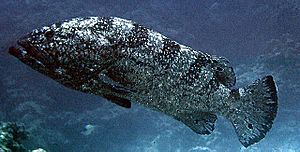Saddletail grouper facts for kids
Quick facts for kids Saddletail grouper |
|
|---|---|
 |
|
| Picture taken in Australia, Elizabeth Reef. Specimen is 40cm in Total Length | |
| Conservation status | |
| Scientific classification | |
| Synonyms | |
|
The saddletail grouper (Epinephelus daemelii) is a large ocean fish. It's also known as black cod or black rock-cod in Australia. In New Zealand, people call it the saddle-tailed grouper or spotted black grouper. This fish belongs to the family called Serranidae.
You can find saddletail groupers along the coastlines of southeastern Australia and northern New Zealand. They usually live near rocky areas and coral reefs. They can be found in waters up to 50 metres deep. Most of them live off the coast of New South Wales in Australia. Some are seen in New Zealand, possibly from young fish that drifted there. However, groups of these fish have been seen breeding in northern New Zealand.
Contents
About the Saddletail Grouper
This amazing fish can grow very large! It can reach up to 200 cm (about 6.5 feet) in length. It can also weigh at least 68 kg (about 150 pounds). That's heavier than many people!
What They Eat
The saddletail grouper is a carnivore, which means it eats other animals. It mostly hunts and eats crustaceans, like crabs and shrimp. It also enjoys eating other smaller fish.
How They Look
Saddletail groupers look like typical groupers. Their colour can change a lot. Some are a dark grey-black colour. Others have a more common pattern of black and white blotches or bands. These patterns help them blend in with their rocky homes.
Life Cycle and Reproduction
Saddletail groupers have an interesting way of reproducing. They are what scientists call protogynous hermaphrodites. This means they start their lives as females. As they get older and bigger, they change into males. This change usually happens when they are about 100–110 cm long. It also happens when they are around 29–30 years old.
Protecting the Saddletail Grouper
In the early 1900s, people noticed that the number of saddletail groupers was going down. This was especially true in areas where many people lived and fished.
Why Their Numbers Dropped
In the 1950s, 1960s, and 1970s, the saddletail grouper population dropped a lot more. This was because spearfishing became very popular. These fish were easy targets for spear fishermen because:
- They are very large.
- They move slowly.
- They are curious and don't always swim away from people.
- They live in shallow, inshore areas where people can easily reach them.
Many saddletail groupers were caught by spear fishermen.
How They Are Protected Now
After many years of their numbers falling, the New South Wales fishery department took action. In 1983, they made it illegal to spear or catch black cod. Later, they officially listed the species as vulnerable. This means it needs special protection. In 2012, the Australian Government also listed it as vulnerable under national environmental laws. These rules help protect the saddletail grouper so it can recover and thrive in the ocean.
See also
 In Spanish: Epinephelus daemelii para niños
In Spanish: Epinephelus daemelii para niños


